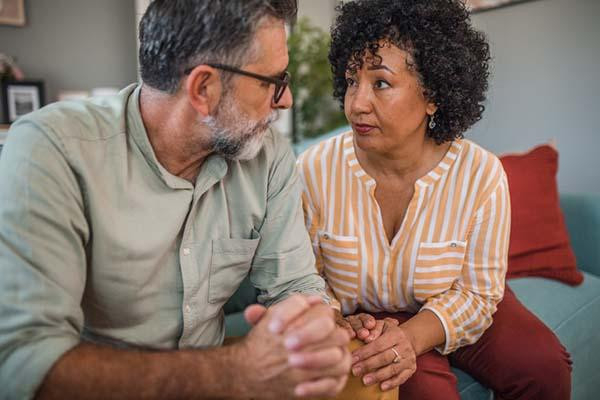
Supporting a loved one with prostate cancer: A guide for caregivers

Looking after a loved one who has prostate cancer can be overwhelming. Caregivers — usually partners, family members, or close friends — play crucial roles in supporting a patient's physical and psychological well-being. But what does that entail? You as a caregiver might not know what to say or how to help.
"Patients diagnosed with advanced cancer are facing their own mortality," says Dr. Marc Garnick, the Gorman Brothers Professor of Medicine at Harvard Medical School and Beth Israel Deaconess Medical Center, and editor in chief of the Harvard Medical School Guide to Prostate Diseases. "And they each process that in different ways."
Dr. Garnick emphasizes the need provide patients and families with the best information possible about the specifics of the diagnosis, symptoms, and available treatments. Some patients have near-miraculous responses to treatment, he says, even when they have very advanced cancer. "We let patients know that there are reasons to be optimistic, as treatments are improving on a regular basis," he says.
Communication
Dr. Garnick points out that clinicians should avoid words or phrases that can leave cancer patients feeling unempowered. A phrase like "Let's not worry about that now," for instance, is dismissive and doesn't respond to a patient's legitimate concerns. Saying "You're lucky your cancer is only stage 2" doesn't allow for the fear and anxiety a patient may have over his disease.
Along similar lines, "It's important for caregivers to be receptive to what their loved ones are saying," Dr. Garnick says. "Instead of minimizing or questioning what your loved one is telling you, try asking 'What do you need? Tell me what you think is going to help you feel better.'"
While it's natural to offer reassurance, you should also give your loved one space to express himself openly without offering quick solutions. Be aware that treatment can lead to emotional ups and downs, so expect mood fluctuations.
One of the most valuable tools you have as a caregiver is the relationship you've built with your loved one over the years. During this challenging time, remind yourself of the bonds you've created together. Shared memories, inside jokes, and mutual interests can provide strength and comfort.
Day-to-day practical support
Managing medications can be challenging. Cancer patients can take a dozen or more pills per day on varying schedules. You can help your loved one stay on track by setting up a pill organizer (available at most drugstores) that sorts medications according to when they're needed.
Patients with advanced prostate cancer are now being treated more often with drug combinations that include chemotherapy as well as hormonal therapies. Chemotherapy can leave patients feeling unusually cold, and patients may also get cold after experiencing hot flashes from hormonal therapy. So keep lots of blankets and warm hats on hand.
Collaborate on a journal where you and your loved one keep health information in one place. It should contain the names and contacts of clinicians on his team, as well as details of his treatment plan. The journal can also double as a diary where you both record treatment experiences.
You might be tasked with coordinating medical appointments. It's important to keep lists of questions you may have. Take notes so you have a record of what doctors and other people on his care team have told you. Also, you should take some time to familiarize yourself with your loved one's insurance policies or Medicare plans so you have a better understanding of what's covered.
Don't forget to take care of yourself!
As a caregiver, it's easy to get lost in your loved one's needs. But caring for someone with cancer while managing household responsibilities can also leave you feeling isolated, burned out, and even depressed. It's essential to also prioritize your own health and well-being.
Make sure that you get enough sleep and exercise. Keep up with your own checkups and screening. Try to eat well, and prepare meals ahead of time to reduce stress and save time on busy days. Take breaks! Caregiving can be intense, so take time to recharge by taking a walk, reading a book, or spending time with friends.
Here are some valuable resources that can help.
Help for Cancer Caregivers provides support on managing feelings and emotions, keeping healthy, day-to-day needs, working together, and long-distance caregiving.
The Prostate Cancer Foundation provides an array of educational materials, including a "caregiver's toolkit" that helps caregivers understand treatment options, side effects, and ways to be actively involved in the decision-making process.
The Patient Advocate Foundation offers case management services to help caregivers and patients understand insurance coverage, financial assistance programs, and other resources that can reduce the financial burden of cancer treatment.
About the Author

Charlie Schmidt, Editor, Harvard Medical School Annual Report on Prostate Diseases
Charlie Schmidt is an award-winning freelance science writer based in Portland, Maine. In addition to writing for Harvard Health Publishing, Charlie has written for Science magazine, the Journal of the National Cancer Institute, Environmental Health Perspectives, … See Full Bio View all posts by Charlie Schmidt
About the Reviewer

Marc B. Garnick, MD, Editor in Chief, Harvard Medical School Annual Report on Prostate Diseases; Editorial Advisory Board Member, Harvard Health Publishing
Dr. Marc B. Garnick is an internationally renowned expert in medical oncology and urologic cancer. A clinical professor of medicine at Harvard Medical School, he also maintains an active clinical practice at Beth Israel Deaconess Medical … See Full Bio View all posts by Marc B. Garnick, MD

A low-tech school vacation: Keeping kids busy and happy without screens

School vacation coming up? Wondering how to spend that time? Given how tiring holidays can be — especially for parents who are working — it’s understandable why children are often allowed to spend hours with the TV, tablet, or video games. After all, happy, quiet kids make for happy parents who can finally get stuff done — or relax.
Except kids are spending way too much time in front of screens. According to the American Academy of Child and Adolescent Psychiatry, kids ages 8 to 12 are spending four to six hours a day watching or using screens — and tweens and teens are spending nine hours.
Given how enticing devices and social media can be, those numbers can easily go higher during unscheduled times like weekends and school vacation. That’s why it’s good to be proactive and come up with other activities. Below are some ideas for parents and caregivers to try. These are mostly good for kids through elementary school, but tweens and teens may enjoy some of them too.
Spending time off the screen
Go outside. This sounds obvious, but spending time outdoors is something kids do less than they used to — and it can be really fun. If you have a yard, go out into it and play hide-and-seek or build a fort from snow or anything else that’s around. If you don’t have a yard, go to a local park or just go for a walk. A scavenger hunt up and down the block or game of I Spy may be a good enticement.
Go to the library. Do this early on in vacation, so that your child has lots of books, puzzles, and games to pass the time. Check out as many as they allow and you can carry. Ask if a Library of Things is available at a branch near you: crafts, tools, musical instruments, birding kits, telescopes — even metal detectors may be checked out for free.
Build a fort in the living room. Use blankets or sheets over chairs; if you have a small tent, set it up. Bring in pillows, sleeping bags, and flashlights; let the kids sleep in it at night. Let it stay up all vacation.
Build a city in the living room. Use blocks, Legos, boxes (or anything else), and add roads, cars, people, animals, trains, and other toys. Let it stay up all vacation, and make it bigger every day.
Getting creative off the screen
Get creative. Go to the craft store and stock up on inexpensive supplies. Buy things like poster board, huge pieces of paper (you could use those for your city, too, to make parks, roads, and parking lots), paints, and markers. You can make a paper mural, a comic book, a story, posters, or whatever catches your child’s imagination. If you know how to knit or sew, think about teaching your child or making a simple project together. Play music while you create.
Read out loud. There are so many books that are fun to read aloud. When my children were younger, we read the Harry Potter series out loud, as well as the Chronicles of Narnia and books by E.B. White and Roald Dahl. Act out the voices. Have some fun.
Have a puppet show. If you don’t have puppets, you can make some with socks — or you can hold up dolls or action figures and do the talking for them. You can make a makeshift stage by cutting out the back of a box and taping cloth (like a pillowcase) to fall over the front.
Get out the games. There are so many that work across the ages, like checkers, chess, Uno, Connect 4, Sorry, Twister, Clue, Scrabble, or Monopoly. We forget how much fun these can be.
Bake. You don’t have to get fancy — it’s fine to use mixes or pre-made cookie dough. There’s nothing better than baked goods straight from the oven, and adding frosting and decorations makes it even more fun. Turn on music and dance while things bake.
While parents or caregivers need to be involved with some of these activities (like the ones involving the oven, or reading out loud), kids can do many of them independently once you have it started. Which, really, is what children need: time to use their imagination and just play.
But you just may find that once you have things started, you'll want to play, too.
About the Author

Claire McCarthy, MD, Senior Faculty Editor, Harvard Health Publishing
Claire McCarthy, MD, is a primary care pediatrician at Boston Children’s Hospital, and an assistant professor of pediatrics at Harvard Medical School. In addition to being a senior faculty editor for Harvard Health Publishing, Dr. McCarthy … See Full Bio View all posts by Claire McCarthy, MD